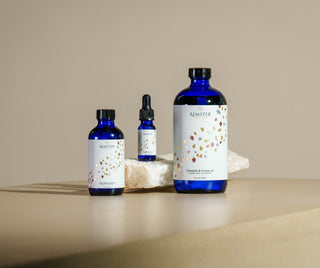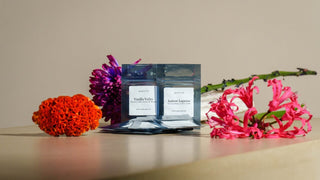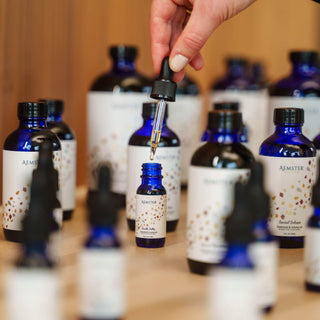Scented storytelling
The human beings that had re-entered Central Europe after the last Ice Age had outgrown the stage of brute apes. They no longer made their way through the wilderness growling and swinging a club. They had become thinking creatures with a certain culture, covered their bodies with clothes, and had a kind of language with which they could express their feelings, anger, and affection. The hunter who was buried by his relatives on a bed of woven pine branches 60,000 years ago in Iran was given a large number of flowers to take with him to his grave. Flowers with their sweet fragrance must have had a meaning for mankind even in those ancient times.
By our standards, those distant ancestors did not have a pleasant smell. According to some researchers, early humans could only survive 20 million years ago because they smelled so bad that they made other animal species flee. Others claim that the first human beings lived in the warm regions of this earth, where they fed themselves with fruit and seeds. Only when it got colder did they invent tools with which they could go hunting. Their diet became richer in protein and fatty acids were displaced. Meat-eating humans developed a different body odor and even a different physique from their vegetarian predecessors because they had to work much harder to obtain food. That sweating early man somehow discovered that he could cleanse his skin with red ochre or iron oxide, which he found in the earth. He used ochre not only for himself but also rubbed it into the animal skins he wanted to preserve. In Africa, a site has been found where, some 43,000 years ago, miners mined ochre and iron oxide. In another old mine, layers of earth containing black manganese oxide were excavated, but only the black dye was likely preserved at that time for use in dyeing textiles, enamel, and glass. These techniques were not yet known to the Africans, but they exchanged the product for oil, spices, and woven fabrics, which were brought in by traders from the Mediterranean regions.
The first humans that looked like us roamed Europe 35,000 years ago, hunting and eating whatever they could find along the way. When the weather conditions became more favorable, he must have decided to settle in the caves that offered him protection.
From the moment that man gave up his nomadic existence, he began to occupy himself more intensively with the earth. He sowed the seeds of grasses and plants he had collected earlier and discovered that the crushed fruits and seeds produced oily oil. With that oil, he could protect his skin from the cold even better than with the animal fats he used before. He also found that some plant roots, leaves, and flowers gave off so much fragrance that, ground into powder, they could be mixed with the oil. He also used those herbs for his food and spread them on the flames of his fireplace, so that the whole area, his family, and his friends were permeated from head to toe with an aromatic smoke smell. All this happened more than eight thousand years ago and it marked the beginning not only of agriculture but also of a form of human life in which aromas and other pleasant odors began to play an important role.
Fire has given man a strong impulse. He must have derived from it a sense of power that gave him incredible self-confidence. The smoke that rose from his fire was a mystery. He saw it but could not grasp it, and it disappeared without leaving a trace in the air. Almost all ancient peoples have seen smoke as a means to reach the gods, the unknown power that controlled their lives. The ancient Peruvians burned fragrant wood on their altars. The Egyptians placed fragrant resins and fine perfumes on their altars and in front of their statues of the gods. So did the priests in the East Indies, China, the Arab countries, and the Israelite Empire. With this consecrated smoke, the incense, they tried to please the heavens, because what people found pleasant, should also be pleasant for higher powers. True incense came from the large Boswellia tree which grows in southern Arabia. Abyssinia, Somaliland and India. The translucent resin droplets, bitter and very fragrant, did not come from the star-shaped flowers but from the trunk. Incense also included the wood of the Sabina and the Junipers, which gave off an aromatic scent when burnt. The incense altar of the temple in Jerusalem had thirteen kinds of incense twenty centuries ago. According to the Old Testament: "Brought from the sea and from the cultivated and uncultivated land, which meant that everything was from and to God". It probably consisted of frankincense, myrrh, cassia, nard, saffron, cinnamon, balsam, and other spices.
The word perfume is very old. It means per fumum (by smoke), and it was used to describe all the odorous substances that could ascend to heaven as smoke.
PARADISE
The Garden of Eden described six thousand years ago in the Bible's book of Genesis, must have been at the heart of the civilization known at that time. The world was then bounded by India to the east, the River Nile to the west, the tip of Arabia to the south, and the Black and Caspian Seas to the north. They spoke of Gan, which means garden, and not of Paradise, for that word was first used in a Greek translation of the Old Testament only 250 years before Christ. Adam and Eve are said to have lived in this garden, which was situated in a valley and had lush vegetation thanks to rivers. The hot and humid regions of the world at that time had many gardens where fragrant flowers were grown for use in temples and houses. In Arab countries, herbs and gums were used not only to honor the gods and embalm the dead. They also knew that the fragrant leaves of some trees had a cooling effect on the temperature, making the atmosphere much fresher. It was probably discovered by accident, but the fact is that at that time it was customary in all regions between present-day Egypt and Jordan to hang green branches above the bed. Fragrant branches were also attached to the ceiling of the living quarters.
In ancient, highly developed Egypt, incense and perfumes were in such great demand that caravans had to travel all over the world to get them. The donkey drivers brought nardus root from the Himalayas and mastic resin from Palestine. Camels, heavily laden with balsam oil, regularly made the harsh crossing of the desert. There was also an "incense route" from Yemen to the north with myrrh from the coastal area of Somaliland. The Ishmaelites, the nomads of northern Arabia, took over the cargo en route and delivered the aromas to the Egyptian palaces. The road snaked for two thousand kilometers through inhospitable terrain, past robbers and guarded trading posts, through sandstorms and oases. Despite the dangers, the trade was so profitable that this incense route lasted for more than two thousand years. When English scholars opened Tutankhamun's tomb in 1922, they found next to the golden sarcophagus, in which the embalmed body of this king had lain for three thousand years, a pair of alabaster vases from which a faint, sweet fragrance emanated. Even more than the gold and jewels in the great Pharaoh's tomb, that perfume revived the memory of the flourishing and wealth of the ancient Egyptian Empire. Perfume and incense were closely intertwined with everyday life. They were used for religious sacrifice, embalming the dead, and personal pleasure. The boundaries between life and death, worship and art, love and war were not as sharply drawn as in later centuries. Priests, kings, and important citizens were anointed with fragrant oil, and from the temples and palaces rose the smoke of incense and aromatic woods. Sacrificial animals were stuffed with herbs before being laid on the funeral pyre to disguise the smell of meat, but also to placate the gods. Nineteen centuries before our era, King Ramses the Third exclaimed in prayer to the god Amon: "Have I not sacrificed three thousand oxen, with all the accompanying aromatic herbs and with exquisite perfumes?"
MYSTERIOUS SMOKE
In the holy city of Heliopolis, the sun god was incensed three times a day: at dawn, around noon, and at sunset. In the temples, they smoked not only the herbs but also the perfumes pressed into pastilles. It is no longer possible to ascertain how many perfumes were smoked in those ancient times, but inscriptions show that the quantities were immense. Queen Hatshepsut built an enormous temple in Dar-el-Bahari in 1500 BC. A colorful relief from that time shows the composition of the expedition she sent to the city of Punt in Somaliland. Five ships sailed from the Red Sea to the south, heavily laden with copper and turquoise. The fleet returned with ebony wood, fragrant sandalwood, ivory, a collection of monkeys, and a large number of incense trees that had been placed root and all in pots. These trees were planted with the utmost care in the queen's garden and the apothecaries who later extracted resin from them were checked for their brightness. Nothing was allowed to disturb the growth of these precious plants. Five centuries later, another queen, who ruled over the southern land of Sheba, traveled to Jerusalem to complain to the mighty King Solomon. Her caravan of balsam and myrrh encountered difficulties as Solomon's kingdom stretched from Jerusalem to Damascus and the Gulf of Aqaba. The queen and her retinue traveled in a long procession of camels and covered the distance from Ethiopia to Jerusalem, more than three thousand kilometers, without stopping. According to tradition, Solomon had seven hundred wives and three hundred concubines, but this harem did not deter the Queen of Sheba. She brought precious gifts like gold and jewels, frankincense and myrrh, and some balsam bushes. But the most valuable gift for the king was her company, for the queen was exceptionally beautiful and intelligent. After "many wise talks" the Queen of Sheba returned to her country. She had not only received a letter of licence for the incense route of her caravan, but also a contract to supply incense to Solomon's kingdom. The queen had surrendered herself with heart and soul to Solomon and most probably the story is true, that she returned with a child of this king in her womb.
CLEOPATRA
Women played an important role in ancient times because national interest, politics, and love were easily interchangeable for the princes. One of these women was Cleopatra, the Egyptian Greek queen, who, thanks to Shakespeare, was given a place in world literature. She wanted to be part of a great and powerful empire, and her friendship with the Roman emperor Julius Caesar had resulted in a son, who could have strengthened their bond. But her lover was murdered and she feared that Egypt would be incorporated into the Roman Empire as an unimportant province. In an attempt to reconnect the two countries, Cleopatra invited Mark Antony aboard her floating palace. As the scarlet sails flapped above their heads, the guests walked to their seats at the table on a carpet of rose petals, held together by nets attached to the walls. The air was heavy with incense and perfume. At the end of the meal, Cleopatra threw a large pearl, worth a fortune in Rome, into pure vinegar, and in one gulp she drank the cup empty to show that her country had unlimited wealth. It was not only priests and princes who surrounded themselves with scents in ancient Egypt. The most sacred perfume from the temples, called Kyphi, found its way into the homes of wealthy citizens. Honey, juniper, acacia, henna, cypress, and wine were used in this perfume. The ingredients had to soak for a long time, after which honey, myrrh, grapes, and resin were added. The mass was beaten and made into a paste, which slowly became stiff. Because of its special composition, Kyphi is said to "lull man to sleep". It would dispel his fears and brighten his dreams. "The perfume is made of things that are especially pleasant at night," wrote a scholar of the time. The rich citizens not only purified their living quarters with this holy perfume but also enriched their bedrooms with it.
EGYPTIAN BATHING CULTURE
The bathing culture of the Egyptians was known far beyond their borders. Their bathhouses with ingenious water pipes later inspired the Romans. They had access to fragrant bath oils and massage creams, and after the bath, women dressed their hair in the shape of a lotus flower. That flower was sacred and considered a symbol of reincarnation. Between the hair strands, Egyptian ladies wore an oblong. It was not a headgear, but a narrow tube of wood or precious metal, which contained a fragrant pomade. As soon as one stepped into the true outdoors, this cream melted and dripped steadily onto the hair and skin of the wearer. Before going to bed, this cream was massaged into the skin and, according to the chroniclers, the women owed their beautiful, young skin to it. Egyptian women had many beauty aids at their disposal. They used green eye paint made from soot, burnt almond skin, lead sulfate with malachite, and green copper carbonate mixed with conifer oils. They outlined their eyes with kohl and their fingers, palms, and soles were colored with henna. Sometimes they dipped their fingers in gold paint. The well-to-do wore wigs and when they visited, their hosts offered them fragrant oil for their shaved heads or even for their wigs. Even then, there was already a cream to prevent wrinkles. A mixture of wax, fresh oil, and the aroma of cypress berries, crushed in fresh milk, was made. According to the instructions, this remedy had to be used for six days at a time. Cleopatra's death meant the definitive end of the mighty Egyptian Empire. But its influence was great and many customs had been adopted by neighboring peoples such as the Greeks, Jews, and Romans.
GREEK HETAIREN
Incense was first brought to Greece by the Phoenicians probably four centuries before our era. Fragrant ointments and oils were used by the Greeks just as abundantly as by the Egyptians. Not only for temple offerings but also especially in the personal sphere. As was to be expected, a ban by the authorities had the opposite effect: a black market in aromatic products developed, which drove the price up even higher. The use of these products was popular among the entire population. Even the careless philosopher Diogenes rubbed his feet with scented ointment. He criticized the Athenians for their frivolous behavior: "Why do you anoint your heads with perfume? It evaporates in the wind and only the birds enjoy it. I anoint my feet and legs so that the scent surrounds the whole body and rises to the nose.
In the first book written on perfume by the Greek Appollonius, it is stated that the best rose perfumes are made in Phaselis, but that the perfumers of Naples and Capua also provide a good product. "Saffron perfume is best bought in Cilicia and Rhodes. Majoran and apple perfume come from the island of Kos and if you want an excellent cypress perfume, you have to import it from Egypt". At the end of a long list, Apollonius writes that it does not matter where the perfume comes from. According to him, it is the people who draw the aromas who determine the quality. One must have good materials and the perfumer must be a true artist...
The perfumers of Greece indeed had the artistic gift of composing beautiful perfumes. The women who led the way in beauty and perfume were gifted courtesans, called hetairen in Greece. The most famous were the beautiful Phryne, worshipped as a goddess, and Aspasia, who was especially admired for her wit. The latter wrote two books on the making of cosmetics, but these works were lost in the great fire of Alexandria. One of her formulas, however, was engraved on a bronze table and placed in the temples of Apollo and Esculapus, right next to that of Hippocrates. This was no coincidence, as cosmetics were still part of the medical sciences at that time. The heathens of Athens surrounded themselves with interesting poets, scholars, and statesmen. Before their "jour" began, they had their slaves massage them from head to toe and then slip into a perfumed bath. They were dried with goose feathers and their tingling skin was then rubbed with fragrant oil from the East. The mouthwash they used to perfume their breath was also fragrant.






